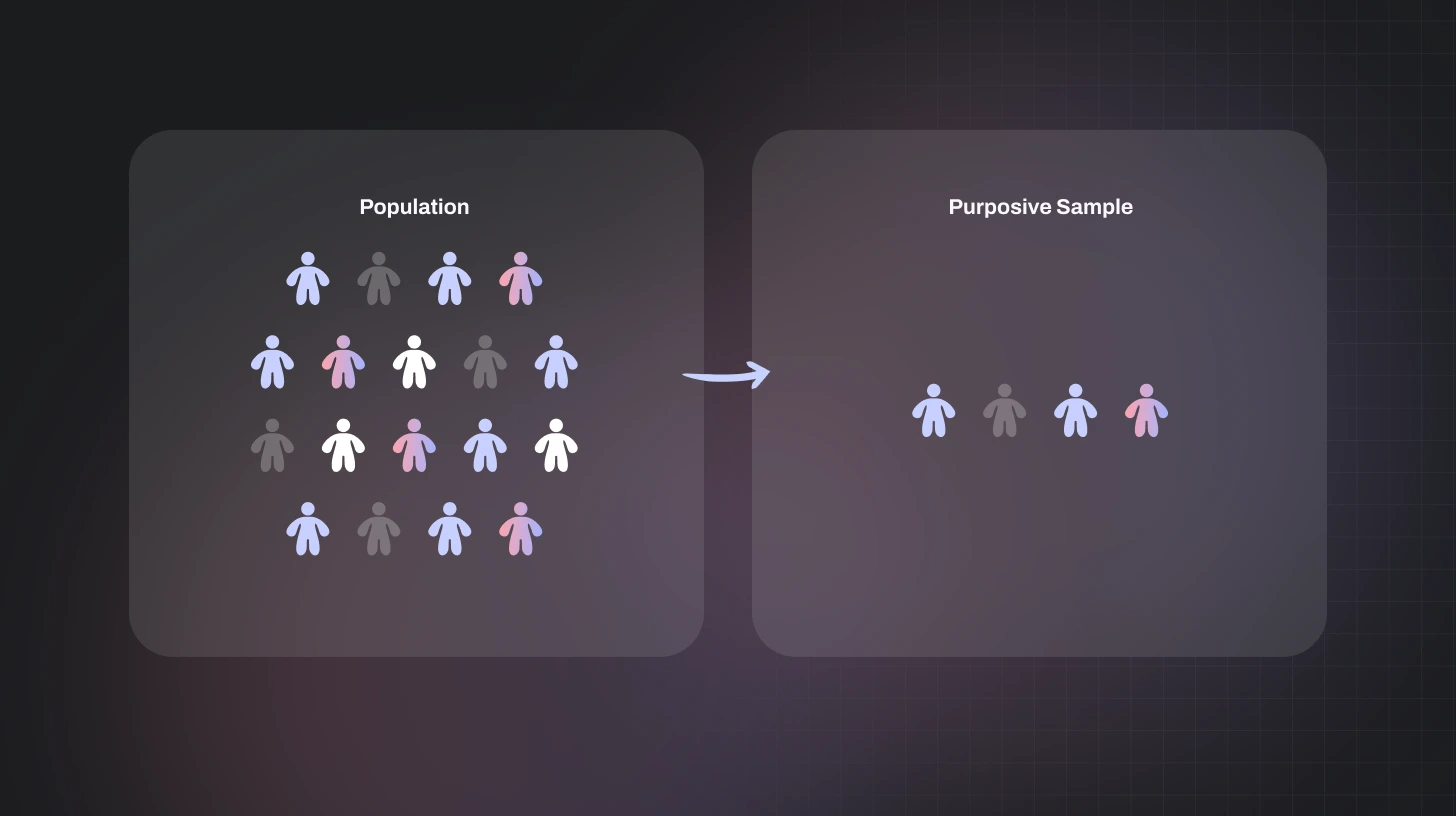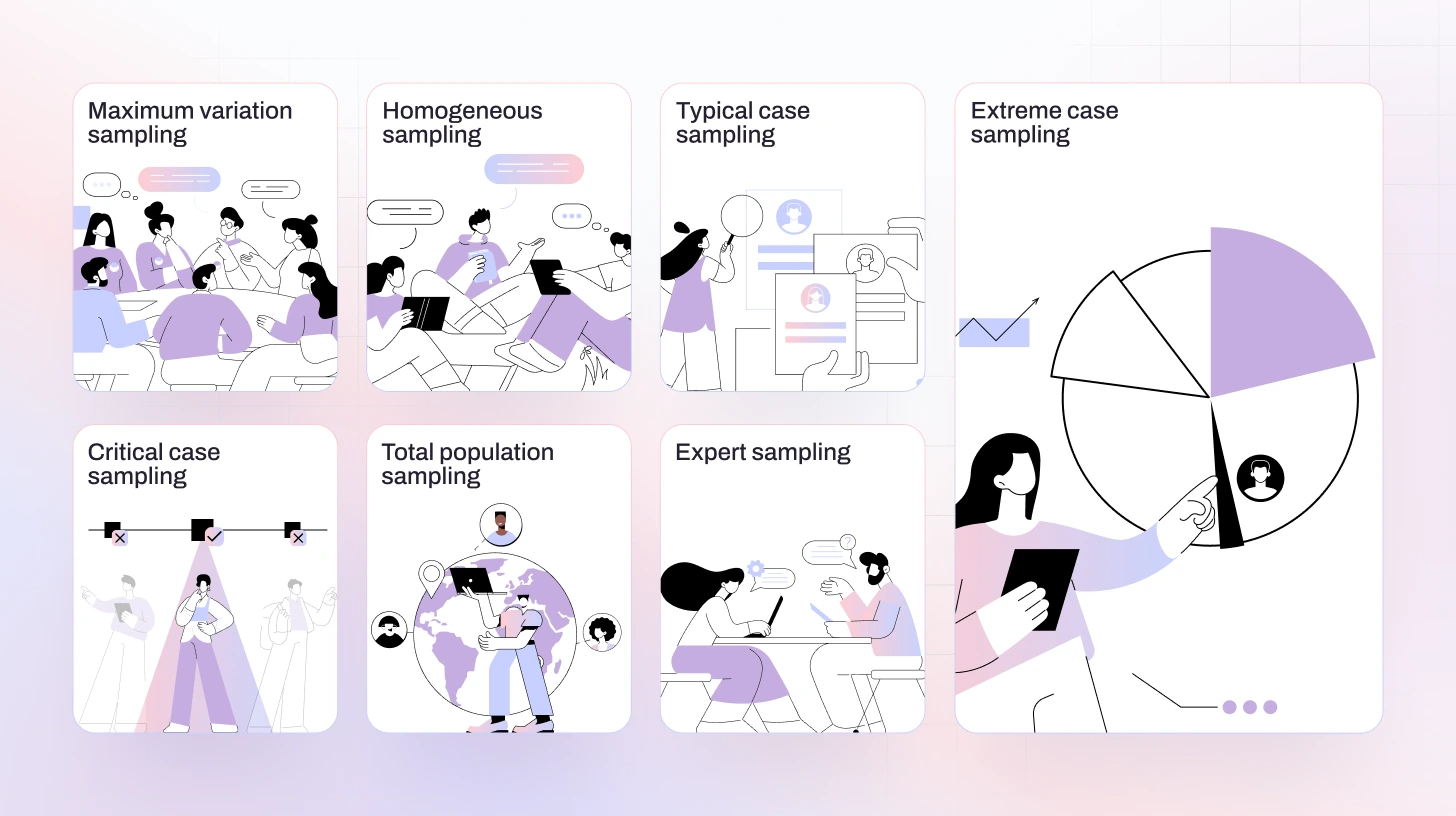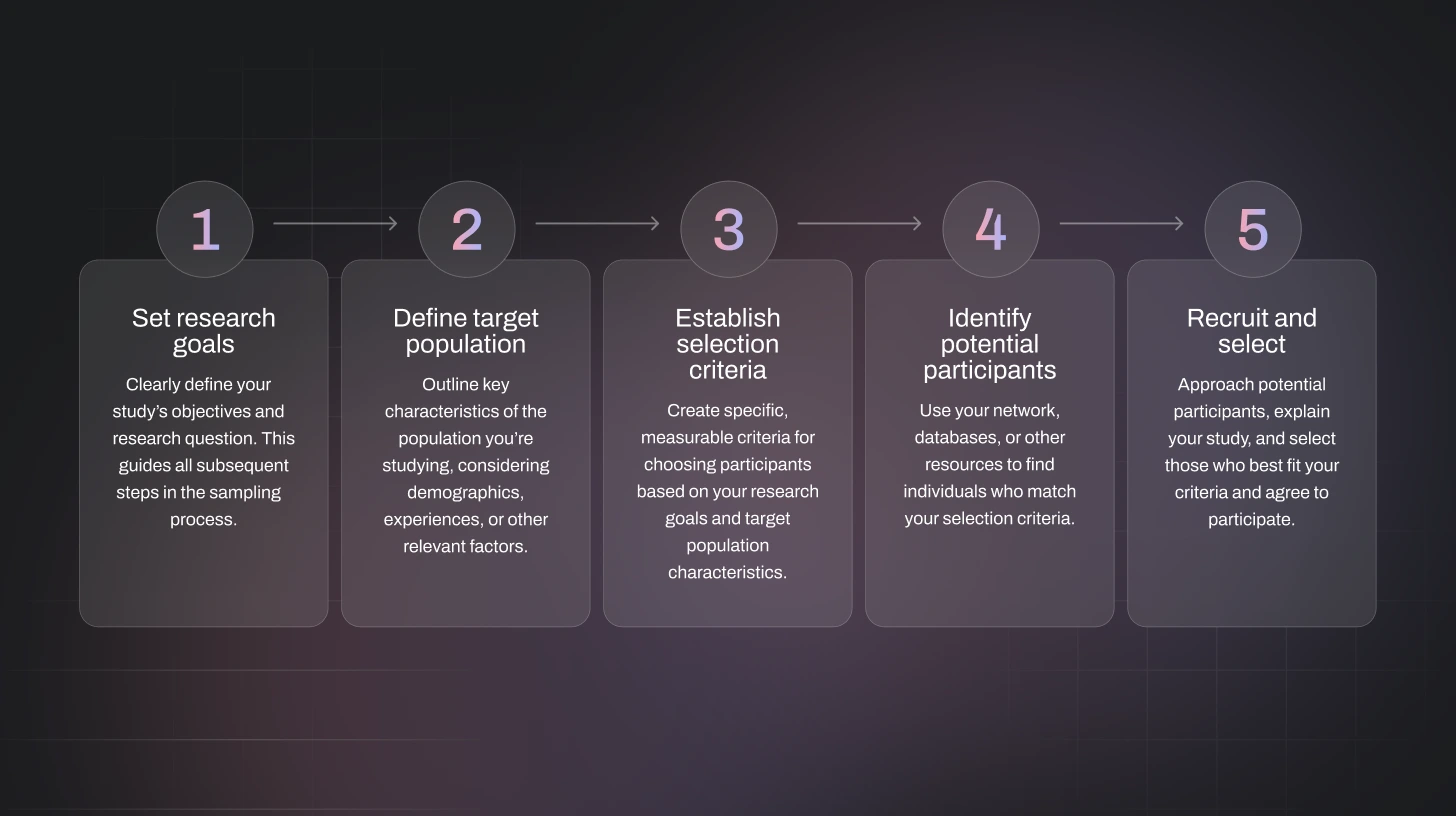 Blog
Blog Purposive Sampling: Definition, Types, Examples, and Applications
Purposive Sampling: Definition, Types, Examples, and ApplicationsPurposive Sampling: Definition, Types, Examples, and Applications

Imagine you are building a focus group. Do you randomly invite people off the street, or do you carefully select the people who live and breathe the problem you are trying to solve?
The answer is Obvious.
That intentional, careful choice is purposive sampling. Instead of casting a wide net and hoping for useful answers, purposive sampling allows you to hand-pick participants who can actually provide the insights you’re looking for. It’s deliberate, focused, and incredibly powerful when you want depth over noise.
TLDR;
When you need insights that really matter, purposive sampling lets researchers handpick participants based on relevance, expertise, or experience. Common in qualitative and exploratory research, it uncovers deep, meaningful insights through techniques like expert, maximum variation, typical case, and extreme case sampling. While time- and cost-efficient, it carries some risk of bias and limited generalizability, but when done right, it helps focus on quality over quantity and study the cases that truly reveal patterns and trends.
Read: Everything You Need to Know About Survey Sampling in Research and Business
What is Purposive Sampling?
Purposive sampling (also called judgmental sampling or selective sampling) is a non-probability sampling technique where researchers choose participants based on characteristics and knowledge. In other words, instead of relying on random selection, the researcher himself identifies who is most relevant to his study.
It is very common in qualitative and mixed-method research. It is especially beneficial when you need information-rich cases or want to maximize the use of limited resources. For instance, a SaaS company may choose to interview only churned customers to understand their reasons for leaving, while a healthcare researcher might focus on patients with a specific ailment to study unique patterns.
On the other hand, purposive sampling increases the risk of research bias, such as observer bias, because the selection is based on the researcher's judgment. Despite this, when used correctly, it can provide deep, targeted insights that random sampling may miss, particularly in investigations where data quality is more important than quantity.

Read - A Complete Guide to Random Sampling Methods and Techniques
Purposive Sampling Types with Examples
Below are the main types of purposive sampling and practical examples of each.
Expert sampling
This involves selecting participants with specialized knowledge or experience relevant to the research question.
For example, if you are investigating trends in AI-driven customer support. You interview AI engineers, product designers, and customer success leaders who implement AI solutions. Their expert perspectives reveal challenges and future trends that typical users might not notice.
Maximum Variation Sampling
Maximum variation sampling, also known as heterogeneous sampling, is used to capture the widest possible range of perspectives. Researchers deliberately include both typical and extreme cases to examine a subject from multiple angles and identify patterns that hold true across variations.
Suppose you are researching challenges in remote work productivity across different companies. Using maximum variation sampling, you select employees from small startups, large enterprises, and mid-sized companies across various industries. This approach helps document a wide range of experiences, from highly productive teams to those struggling with remote collaboration.
Homogeneous Sampling
Homogeneous sampling, in contrast, aims to reduce variation by focusing on a specific subgroup with shared characteristics. This approach simplifies analysis and allows researchers to describe the experiences of a particular group in depth.
Continuing the remote work study, you might focus only on team leads within tech startups. Interviewing participants from this subgroup allows you to explore how leadership styles and team dynamics influence productivity in similar organizational environments.
Typical Case Sampling
Typical case sampling is used to highlight what is considered a normal or average instance of a phenomenon. Participants are selected based on their likelihood of representing the standard experiences of a population.
For example, imagine you’re studying how families use public libraries. Instead of focusing on heavy readers or people who never visit, you could select families who visit the library once or twice a month. Their habits reflect the “typical” usage pattern, making them a strong representation of the average library-goer.
Extreme (Deviant) Case Sampling
Extreme case sampling focuses on outliers or unusual cases to uncover unique insights. This can involve cases with exceptional success or failure, often useful when exploring best practices or potential pitfalls.
For example, researching heart surgery recovery rates, you might focus on patients who recovered significantly faster or slower than average. Understanding these extreme cases can reveal factors that influence recovery outcomes.
Critical Case Sampling
Critical case sampling is used when a single or very few cases can provide insights relevant to other similar cases. The guiding principle is: “If it happens here, it will likely happen elsewhere.”
For example, in a study of community engagement in local government, you could interview officials with high expertise in regulations. If even they struggle to understand certain processes, it’s likely that the general public will too.
Quota Sampling
Quota sampling involves selecting participants to ensure specific subgroups are represented in predetermined proportions. This method ensures diversity while maintaining control over the sample composition.
Suppose you are studying employee satisfaction in a multinational SaaS company. You want to ensure that your survey includes equal representation from junior staff, mid-level managers, and senior executives. Using quota sampling, you deliberately select participants from each level so that all perspectives are included in the analysis.
Theoretical sampling
Theoretical sampling is primarily used in qualitative research, where participants are chosen based on emerging insights or developing theories. Rather than defining the sample entirely upfront, researchers select new participants as patterns or hypotheses emerge during the study.
Imagine you are researching how mid-sized SaaS companies adopt AI customer support tools. Initially, you interview a few early adopters and notice a trend: companies with dedicated AI teams adopt faster. Using theoretical sampling, you then select additional participants from companies that fit this emerging pattern to explore the trend further.

Recommended Read: Probability vs Non-Probability Sampling: A Complete Guide for Researchers
Step-by-Step Process to Implement Purposive Sampling
Purposive sampling is widely used in qualitative research when the goal is to focus in depth on a particular phenomenon. The following five steps outline how to implement purposive sampling effectively.
Step 1: Define Your Research Problem
Start by clearly identifying the research problem. This should highlight a specific challenge, gap, or issue that your study aims to explore.
Suppose you are studying the adoption of sustainable packaging practices in the food industry. Your research problem could focus on understanding which strategies lead to the most successful implementation among mid-sized companies.
Step 2: Determine Your Population
Next, define the population from which you will draw your sample. This ensures your findings are grounded in a relevant context.
Example: Target Population
Your target population might include sustainability managers and operations directors from mid-sized food manufacturers that have recently implemented eco-friendly packaging initiatives.
Step 3: Define the Characteristics of Your Sample
In purposive sampling, you select participants who are likely to provide rich, relevant information. You can focus on specific traits, experiences, or expertise.
You may choose:
- Extreme case sampling: Companies that saw dramatic reductions in packaging waste or cost overruns to learn what drove these outcomes.
- Maximum variation sampling: Companies with varying success levels, from highly effective to moderately successful, are used to identify patterns that influence adoption.
Step 4: Collect Your Data Using Appropriate Methods
Once your sample is defined, select the best method to gather information. This can include interviews, surveys, focus groups, or observations.
Example: You conduct in-depth interviews with sustainability managers and packaging team leads to understand their processes, challenges, and strategies. Recruitment continues until data saturation is reached, when no new insights are emerging.
Step 5: Analyze and Interpret Your Results
Purposive sampling provides detailed insights but can be biased. Document your methodology, acknowledge limitations, and avoid overgeneralizing beyond your sample.
Example: After analyzing interviews, you identify themes such as employee engagement, supplier collaboration, and cost-management strategies. You report findings while noting they are specific to mid-sized food manufacturers and may not directly apply to other industries.

Read - Sampling Design Explained: Steps, Challenges, and AI Solutions
Advantages of Purposive Sampling
In-Depth Insights: By selecting participants with specific knowledge or experience, researchers can collect detailed and highly relevant information that provides deeper understanding of the topic.
Time and Cost Efficient: Compared to large-scale random sampling, purposive sampling requires fewer resources, making it practical for small-scale or exploratory research.
Flexibility: With multiple techniques such as expert sampling, extreme case sampling, or homogeneous sampling, researchers can adapt the method to fit the study’s objectives.
Focus on Rare or Unique Cases: When studying specialized populations or hard-to-reach groups, purposive sampling allows researchers to target the most informative participants.
Practical When Data Sources Are Limited: If the pool of qualified participants is small or specific, purposive sampling may be the only viable approach.
Disadvantages of Purposive Sampling
Potential for Researcher Bias: Since participants are chosen based on judgment, personal biases can influence the selection process, affecting the study’s credibility.
Limited Representativeness: Findings may not generalize to the broader population, making it difficult to claim that results apply universally.
Challenging to Justify: Because selection is subjective, convincing others of the study’s validity or replicability can be harder compared to probability sampling.
Risk of Missing Alternative Perspectives: Focusing on specific participants may exclude relevant viewpoints, potentially overlooking important insights.
Not Suitable for Statistical Generalization: This method is primarily qualitative, so it cannot produce findings that are statistically representative of the population.
Read: A Complete Guide to Stratified Random Sampling for Researchers
When to Use Purposive Sampling
Purposive sampling works best when your study focuses on a small, specific group rather than a broad population. It’s ideal for situations where you need participants who share particular traits, experiences, or expertise, or when your research involves distinctive or unusual cases that can shed light on the topic.
The main purpose of this method is to target the individuals or cases most likely to provide meaningful insights. It is especially effective when you already have a clear understanding of the subject, as prior knowledge allows you to select participants who can contribute the most valuable and relevant data to your research.
Purposive Sampling vs. Probability Sampling
Purposive sampling relies on the researcher’s judgment to select relevant participants, while probability sampling uses random selection to ensure representativeness.
The table below highlights the key differences between these two approaches:
Purposive Sampling vs. Convenience Sampling
Purposive sampling carefully selects most relevant participants, while convenience sampling chooses participants based on ease of access.
The table below summarizes the main differences:
Read: Sampling Error Explained: Definition, Types, and How to Reduce It
How TheySaid Makes Purposive Sampling Easier
Purposive sampling is all about choosing the right participants to get meaningful, actionable insights. But manually identifying and reaching the right people can be time-consuming and prone to bias. That’s where TheySaid comes in. With AI-powered surveys and interviews, TheySaid helps you hand-pick the most relevant participants, automatically analyze responses, and uncover deep insights, all while saving time and resources. Whether you’re researching customers, employees, or niche user groups, TheySaid makes purposive sampling smarter, faster, and more accurate.
FAQs
How is purposive sampling different from random sampling?
Unlike random sampling, which gives everyone an equal chance of being selected, purposive sampling focuses on quality over quantity. You hand-pick participants based on knowledge, experience, or relevance to your research goals.
How do I choose the right purposive sampling technique?
It depends on your goal: use typical case sampling for average trends, extreme case sampling for outliers, expert sampling for specialized knowledge, or maximum variation sampling for diverse perspectives.
Can I combine purposive sampling with other methods?
Yes! Many researchers combine purposive sampling with other techniques, such as quota sampling or snowball sampling, to maximize insights while maintaining some level of diversity.






%20Surveys_%20Types%2C%20Benefits%20%26%20Success%20Strategies.webp)








.svg)